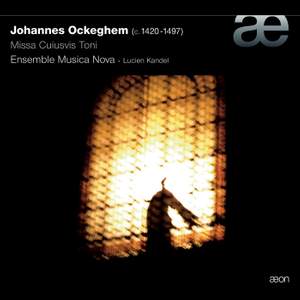Ockeghem: Missa Cuiusvis Toni
Ensemble Musica Nova, Lucien Kandel
This is a recording that was waiting to happen: to do full justice to Ockeghem's famous Mass designed for performance 'on whatever tone you choose', you really need to hear several complete versions... — More…
-
Gramophone MagazineFebruary 2008Editor's Choice
2 CDs
$27.00Downloads
What are FLAC and MP3?Contents
Ockeghem: Messe in D
Work length27:09
$6.00
$9.10
- Ensemble Musica Nova
I. Kyrie
Track length2:15
$1.00
$1.50
II. Gloria
Track length4:45
$1.00
$1.50
III. Credo
Track length7:57
$1.50
$2.30
IV. Sanctus
Track length7:41
$1.50
$2.30
V. Agnus Dei
Track length4:31
$1.00
$1.50
Ockeghem: Messe in F
Work length26:59
$6.00
$9.10
- Ensemble Musica Nova
I. Kyrie
Track length2:13
$1.00
$1.50
II. Gloria
Track length4:40
$1.00
$1.50
III. Credo
Track length8:02
$1.50
$2.30
IV. Sanctus
Track length7:44
$1.50
$2.30
V. Agnus Dei
Track length4:20
$1.00
$1.50
Ockeghem: Messe in E
Work length26:46
$6.00
$9.10
- Ensemble Musica Nova
I. Kyrie
Track length2:08
$1.00
$1.50
II. Gloria
Track length4:38
$1.00
$1.50
III. Credo
Track length7:57
$1.50
$2.30
IV. Sanctus
Track length7:38
$1.50
$2.30
V. Agnus Dei
Track length4:25
$1.00
$1.50
Ockeghem: Messe in G
Work length26:38
$6.00
$9.10
- Ensemble Musica Nova
I. Kyrie
Track length2:10
$1.00
$1.50
II. Gloria
Track length4:31
$1.00
$1.50
III. Credo
Track length7:48
$1.50
$2.30
IV. Sanctus
Track length7:43
$1.50
$2.30
V. Agnus Dei
Track length4:26
$1.00
$1.50
Ockeghem: Intemerata : Intemerata Dei Mater
Work length7:32
$1.50
$2.30
- Ensemble Musica Nova






